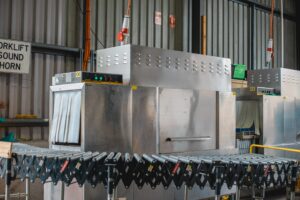Technology has been the driving force behind many of humanity’s most significant developments. From transport and communication to power and industry, the world would be a very different place without many of the innovations we’ve seen in the last decade alone. In this blog post, Tata Communications’ Ankur Jindal, Vice President and Global Head of Corporate Venturing and Innovation, looks at how technology can be used for good.
It’s been inspiring to see a whole new generation of tech start-ups crop up, focusing their energies on developing IoT applications, sensors and devices to monitor all kinds of physical actions and activities to address a range of humanitarian, social and environmental issues.
For example, Aclima uses mobile and stationary sensors to measure air pollution at a hyperlocal level; Grind2Energy uses IoT sensors to ensure that its food-waste recycling system is as  efficient as possible; and farmers now have a wealth of technology options available to them, including Cowlar to monitor livestock, Semios for more effective crop management, and Smart Elements to record everything from soil moisture content to water tank levels.
efficient as possible; and farmers now have a wealth of technology options available to them, including Cowlar to monitor livestock, Semios for more effective crop management, and Smart Elements to record everything from soil moisture content to water tank levels.
“Enhanced IoT connectivity has led to massive amounts of data being captured, which presents challenges as well as opportunities when it comes to its management and turning it into actionable insights.”
Making sense of the data humanly possible to process and analyse – which is where artificial intelligence (AI) and machine learning (ML), powered by advancements in high speed computing, come in. These technologies can crunch numbers at a rate that humans can never hope to compete with, making it possible to identify trends and patterns that would otherwise take an age to find.
This, of course, can be helpful to businesses of all kinds, but tech-for-good start-ups such as climate forecaster Cervest are using it to help give a better understanding of environmental issues. Cervest’s Earth Science AI platform uses probability theory, satellite imagery and geoscience to give early warnings concerning extreme weather events and provide insights into how the earth’s natural resources will respond to environmental changes. This could revolutionise global food systems and make production more sustainable.
Elsewhere, Medopad, a London-based digital healthcare company, is using AI and predictive analytics to conduct trials into the early identification of complications related to various serious illnesses, including cancer and heart disease. One of its first projects, a partnership with Chinese company Tencent, involves a motion-capture system that can detect and assess joint movements and facial features of Parkinson’s sufferers in real time. It can identify the frequency, range and intensity of movement, without requiring the patient to travel to a clinic for assessment. Medical professionals can then carry out a consultation remotely.
Similar technology has also been used to help people with autism interact in social situations; help verify and validate information and minimise bias; manage infrastructure and logistics; and even fight against elephant poaching in Africa.
 One of the most common day-to-day uses of AI at the moment is in chatbots, which are most commonly encountered in customer service interactions. But as well as helping you to book a flight, choose a wine to go with your dinner, order a pizza, or even chat with Einstein, chatbots are increasingly being used for social good too. DoNotPay, a smartphone-based chatbot originally designed to help people contest parking fines, has also been used to provide refugees with legal advice and help them to complete and submit assistance and residence forms.
One of the most common day-to-day uses of AI at the moment is in chatbots, which are most commonly encountered in customer service interactions. But as well as helping you to book a flight, choose a wine to go with your dinner, order a pizza, or even chat with Einstein, chatbots are increasingly being used for social good too. DoNotPay, a smartphone-based chatbot originally designed to help people contest parking fines, has also been used to provide refugees with legal advice and help them to complete and submit assistance and residence forms.
“There are sometimes fears that these disruptive technologies will replace human beings in the workplace but with philanthropic pursuits often underfunded, investing in them for the long term can help to ease the burden on overworked staff, particularly in the healthcare industry.”
When more than half of the world’s population doesn’t have access to basic healthcare, mental health assistance often gets forgotten – but there are also numerous examples of chatbots being used for mental health treatment.
Woebot is based on the principles of cognitive behavioural therapy, which research suggests can be just as effective when delivered over the internet as face-to-face. The chatbot, which is available for both Android and iOS smartphones, provides techniques that are proven to help reduce symptoms for people suffering from anxiety and depression. The fact that it’s always available, at any time of the day or night, is particularly key.
“Woebot isn’t alone either. In 2019, many charities submitted chatbot proposals to Tech For Good in the hope of securing funding. Ideas included chatbots to help bereaved children, HIV patients, people suffering from bipolar disorder, and young people with mental health issues.”
Sometimes it can be hard to justify investing in products that don’t directly contribute to increased profits but when these technologies have the potential to improve the lives of so many people  across the world, financial concerns shouldn’t be allowed to dominate the thinking surrounding their development. There’s also great value in data, meaning companies that collect it must be encouraged to make their findings available for the greater good rather than selling it to the highest bidder.
across the world, financial concerns shouldn’t be allowed to dominate the thinking surrounding their development. There’s also great value in data, meaning companies that collect it must be encouraged to make their findings available for the greater good rather than selling it to the highest bidder.
As these products get more popular the possibilities for their deployment become more prevalent – and as the costs involved go down the impact will only go up. Technology is often portrayed to be the catalyst for a dystopian society but, just as steam railways or x-rays revolutionised the world in a way which could never have been anticipated, modern day technologies have the potential to transform lives and societies.
Discover more about some of the top tech developments from the past 10 years.
Transformational Hybrid SolutionsOur cloud-enablement services offer the best performance on your traffic-heavy websites or mission-critical applications.
Core NetworksTata Communications™ global IT infrastructure and fibre network delivers the resources you need, when and where you need them.
Network Resources
Unified Communications As A ServiceBreak the barriers of borders efficiently and increase productivity with Tata Communications’ UC&C solutions.
Global SIP ConnectEmpower your business with our SIP network and witness it grow exponentially.
InstaCC™ - Contact Centre As A ServiceCloud contact centre solutions for digital customers experience and agent productivity.
DIGO – Communications Platform as a ServiceDIGO is an in-network cloud communications platform, enabling you to power up converged contextual human-to-everything conversations globally.
Unified Communication Resources Case studies, industry papers and other interesting content to help you explore our unified communications solution better.
IoT SolutionsThe Internet of Things is transforming the way we experience the world around us for good. Find out more about our Internet Of Things related solutions here.
Mobility SolutionsTata Communications’ mobility services enable your enterprise to maintain seamless communication across borders, with complete visibility of cost and usage.
Mobility & IoT Resources
Multi-Cloud SolutionsWith enterprises transitioning to a hybrid multi-cloud infrastructure, getting the right deployment model that yields ROI can be a daunting task.
Cloud ComplianceCompliant with data privacy standards across different countries and is also designed to protect customers’ privacy at all levels.
IZO™ Cloud Platform & ServicesIZO™ is a flexible, one-stop cloud enablement platform designed to help you navigate complexity for more agile business performance.
Managed Infrastructure ServicesIntegrated with our integrated Tier-1 network to help your business grow efficiently across borders.
Cloud PartnersWe support a global ecosystem for seamless, secure connectivity to multiple solutions through a single provider.
Cloud Resources
Governance, Risk, and ComplianceRisk and Threat management services to reduce security thefts across your business and improve overall efficiencies and costs.
Cloud SecurityBest-in-class security by our global secure web gateway helps provide visibility and control of users inside and outside the office.
Threat Management - SOCIndustry-leading threat-management service to minimise risk, with an efficient global solution against emerging security breaches and attacks.
Advanced Network SecurityManaged security services for a predictive and proactive range of solutions, driving visibility and context to prevent attacks.
Cyber Security ResourcesCase studies, industry papers and other interesting content to help you explore our securtiy solution better.
Hosted & Managed ServicesTata Communications provide new models for efficient wholesale carrier voice service management. With our managed hosting services make your voice business more efficient and better protected
Wholesale Voice Transport & Termination ServicesYour long-distance international voice traffic is in good hands. End-to-end, voice access & carrier services which includes voice transport and termination with a trusted, global partner.
Voice Access ServicesTata Communication’s provide solutions which take care of your carrier & voice services, from conferencing to call centre or business support applications.
Carrier Services Resources
CDN Acceleration ServicesOur CDN Web Site Acceleration (WSA) solution helps deliver static and dynamic content, guaranteeing higher performance for your website.
CDN SecuritySafeguard your website data and customers’ information by securing your website from hacks and other mala fide cyber activities.
Video CDNDeliver high-quality video content to your customers across platforms – website, app and OTT delivery.
CDN Resources
Elevate CXIncrease customer satisfaction while empowering your service team to deliver world-class customer experience and engagement.
Live Event ServicesTata Communications’ live event services help battle the share if eyeballs as on-demand video drives an explosion of diverse content available on tap for a global audience.
Media Cloud Infrastructure ServicesTata Communications’ media cloud infrastructure offers flexible storage & compute services to build custom media applications.
Global Media NetworkTata Communications’ global media network combines our expertise as a global tier-1 connectivity provider with our end-to-end media ecosystem.
Use CasesUse cases of Tata Communications’ Media Entertainment Services
Remote Production SolutionsMedia contribution, preparation and distribution are highly capital-intensive for producers of live TV and video content, and their workflows are complex.
Media Cloud Ecosystem SolutionsThe Tata Communications media cloud infrastructure services offer the basic building blocks for a cloud infrastructure-as-a-service.
Global Contribution & Distribution SolutionsTata Communications’ global contribution and distribution solution is built to reduce capital outlay and grow global footprint.
Satellite Alternative SolutionsAs more and more consumers choose to cut the cord & switch to internet-based entertainment options, broadcasters are faced with capital allocation decisions.
LeadershipA look into the pillars of Tata communications who carry the torch and are living embodiment of Tata’s values and ethos.
Culture & DiversityHere at Tata Communications we are committed to creating a culture of openness, curiosity and learning. We also believe in driving an extra mile to recognize new talent and cultivate skills.
OfficesA list of Tata Communications office locations worldwide.
SustainabilityTata Communications adopts a holistic approach and harnesses the power of new-age technologies like 5G, IoT and AI to build a sustainable digital world.
FAQCheck out our FAQs section for more information.
BoardHave a look at our board of members.
ResultsFind out more about our quarterly results.
Investor PresentationsFollow our repository of investor presentations.
FilingsGet all information regarding filings of Tata communications in one place.
Investor EventsAll investor related event schedule and information at one place.
GovernanceAt Tata, we believe in following our corporate social responsibility which is why we have set up a team for corporate governance.
SharesGet a better understanding of our shares, dividends etc.
SupportGet all investor related contact information here.


